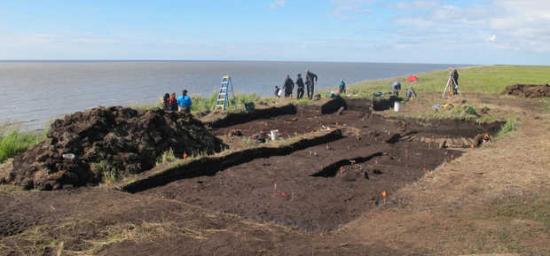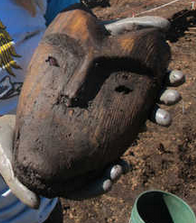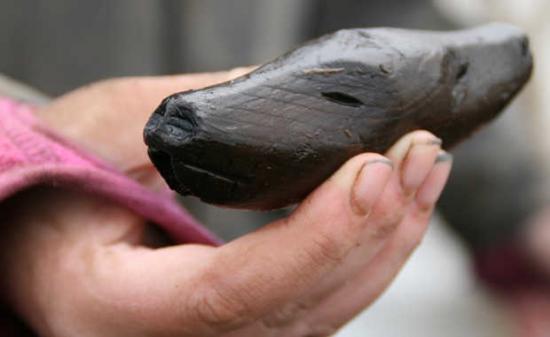Mike Dunham
Source - http://www.adn.com/2013/08/17/3029698/excavation-underway-of-largest.html#storylink=cpy

The Nunalleq site includes more than 50-two by-two-meter excavation blocks opened in August, 2013, in a race to save this archaeological site from erosion. Melting permafrost has increased erosion on the site to as much as 6 feet of shoreline loss every year. The 2009 and 2010 excavation blocks have already been washed away. DEPT. OF ARCHAEOLOGY — University of Aberdeen
Unfamiliar items washed out on the beach near the Bering Sea village of Quinhagak about five years ago. The curiosities were clearly indigenous to the area, with designs similar to those found in the Yup'ik Eskimo culture of the region. And they were wood, a material that usually decays after a few decades. Yet they were also old.
The question was: How old?
Warren Jones, general manager of Qanirtuuq, Inc., the village corporation, took some pictures and sent them to anthropologist Rick Knecht. Knecht, who helped establish museums in Kodiak and Unalaska, recognized the artifacts as prehistoric -- that is, before contact between the Yup'ik and Europeans in the 1800s. "I had a project on Nunivak (Island) at the time, so I stopped by to have a look," said Knecht, a former University of Alaska Fairbanks professor now working for the University of Aberdeen in Scotland. He examined the area and discussed the possibility of doing a dig with Jones.
The upshot was a partnership between Qanirtuuq and the Scottish university that is uncovering an unprecedented trove of archaeological treasure. "This is easily the largest collection of pre-contact Yup'ik material anywhere," Knecht said, thousands of items dating from between 1350 and 1670.
Some of the most important pieces from previous years' digs are now on display at the King's Museum in Aberdeen, an exhibit titled "Nunalleq," Yup'ik for "the old village." It will remain on view through Sept. 7.

This spoon-shaped tool was made from caribou antler and was used to scrape sea mammal gut which was dried and sewn together to make rain gear. DEPT. OF ARCHAEOLOGY — University of Aberdeen
The grant for the work -- $1.7 million funded by the United Kingdom's Arts and Humanities Research Council -- anticipates that the discoveries will be returned to the region for display and study within a few years.
Teams of international volunteers working with local residents have found 8,000 of what Knecht calls "better artifacts." There are perhaps that many more fragments, all containing information about life in the area centuries ago. And every day, it seems, new and eye-popping tools or decorative items are retrieved from the ground. There are carvings, weapons, woven grass, clothing, dolls, even haircut trimmings from long-departed inhabitants. "We found some amazing pieces on Saturday," Knecht said last week. "I've never seen anything like it."
MARVELOUS PRESERVATION

The only complete, full-sized mask found on the site so far. It depicts a human-wolf transformation in that it has features of both a wolf and a human. Transformation is a common theme in arctic artwork, reflecting ancient shamanic beliefs that animals could sometimes transform themselves into humans and vice-versa. This mask still bears traces of silver colored surface paint, probably made from ground mica. DEPT. OF ARCHAEOLOGY — University of Aberdeen
The first test holes were dug in 2009. They were small, about six feet across, but the abundance of material showed that the site had been occupied for a long while and that the settlement likely consisted of 200-300 people.
The following year, the dig was expanded. This August between 15 and 20 volunteers from around the world joined Quinhagak residents in a "field school," currently excavating the site that now stretches for about 150 yards. It's not just the amount of items found at the site that has Knecht excited; it's the quality and rarity of the materials. "Because it's been in permafrost up until now, the level of preservation is just marvelous," he said. "Eighty percent of what we're finding is wood or other organics. A lot of them are preserved to the extent that they still have original paint on them. For all practical purposes, we're looking at new wood."
That's important because so many of the things used by the people of Nunalleq were made from wood and other organic materials. In most circumstances such items decompose within a century or so. Here, however, excavators have found intact wooden masks, bowls, bows, arrows and spears. "Not just the bone points, but the shafts," Knecht said.
"We have scraps of sealskin clothing with original needle holes," he said, "animal fur, little bodies of insects," and in one instance a mouse. "The grass basketry -- sometimes the grass is still a little green. You can see it fade as oxygen hits it when it's uncovered. There's cordage, ropes made from grass and roots. It's very rare to find them."
The crew is also finding stone tools and clay pots, technologies that were abandoned early in the initial contact period. But even those durable items are poorly documented in the Yukon-Kuskokwim region, several hundred miles west of Anchorage. "There are very few archaeological projects in this area, which is about the size of Great Britain," Knecht said. "It's the biggest black hole in our knowledge of prehistory. There's been so little archaeology in Yup'ik country that everything we find here is a revelation."
URGENT WORK

This ulu handle has the image of a wolf–like beast on either end. It would have held a semi-lunar blade of ground slate. DEPT. OF ARCHAEOLOGY — University of Aberdeen
Knecht said the dates of the objects are important, because they bracket a particularly intense chill in the so-called Little Ice Age, an abrupt period of colder-than-usual temperatures and ice advances recorded between 1430 to 1455. It wiped out the Norse settlements in Greenland and hammered crops throughout the northern hemisphere of the Old World. The destruction was well documented in court records in Europe and Asia. But how did it affect Alaskans?
That's something Knecht hopes the old village can tell us. "From this site we can learn a huge amount about how people lived before and after the ecosystems changed."
Knecht thinks the old village was likely a winter gathering place on the Arolik River, south of modern Quinhagak. It was abandoned after the river shifted. The land is famously moving in this part of the world, constantly rearranged by rivers and ocean currents. The shoreline is rapidly eroding at the old village. "Most of (the site) may have been washed away already," Knecht said. "We may just be looking at a portion of it. Maybe a quarter of the original site is left -- and it's going fast." The ocean has already taken out the original dig site, he said. "If we hadn't done the work we did in 2009, 2010, everything, about 8,000 pieces, would have been lost. We're just barely staying ahead of it. It's kind of an emergency."
CULTURAL REVIVAL
On Aug. 28, as this year's work winds down, Knecht and Jones will show the season's finds to Quinhagak residents and hold a community discussion. Then the items will be sent to Scotland for study and preservation. The wood will get a long soak in fresh water to remove marine salts. Then a waxy glycol will replace the fresh water at the cellular level so that the items won't crack as they dry. Institutions in Denmark, Germany and Canada are also participating in the analysis and cataloging of the material.
By 2017 the artifacts will come back to Alaska, Knecht said, ostensibly to a museum in or near Quinhagak where the best pieces will be on display. "We're also working with AVCP (the Association of Village Council Presidents) who are developing an archaeological repository with climate control and storage space for things that wouldn't necessarily be on display," he said. "Kind of like the vault for the family heirlooms."
Beyond preserving the relics of Alaska antiquity for scholars, modern day artists and curious visitors, the proposed facility could have a positive impact on the entire region, Knecht said confidently. He's seen it happen before. "There are parallels with what happened in Kodiak," he said. An unexpected find near Karluk generated excitement around the island and eventually led to the building of the Alutiiq Museum and Archaeological Repository. "There weren't any local artists or dance groups on Kodiak until then. The whole cultural revival movement grew up from that avalanche of interest." Something similar happened in Unalaska, he added. "These discoveries can restore cultural landscapes that have been lost."
ONLINE: Find out more about the Quinhagak discoveries, including photos of "the artefact of the day" at nunalleq.wordpress.com.